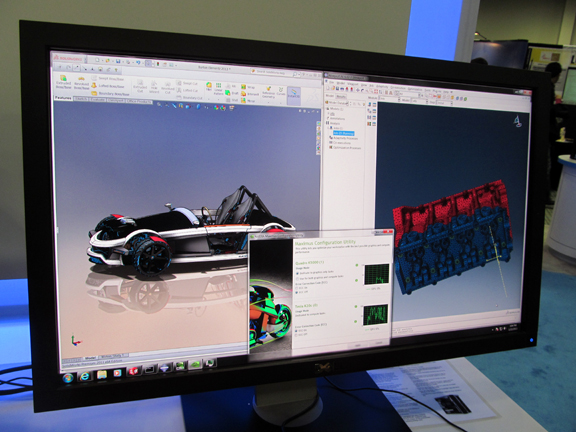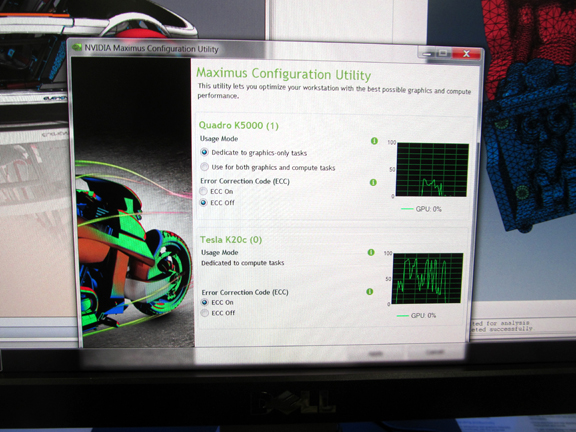January 22, 2013
NVIDIA’s annual GPU Technology Conference (March 18-21, San Jose, California) is still a good six weeks away, but if you’re in Orlando, Florida, for SolidWorks World 2013 (Jan 20-23, Disney World Swan & Dolphin Hotel), you could catch a glimpse of GPU’s future in the partner pavilion. The graphics chip maker occupies a corner in Dell’s booth, where it’s showcasing a variety of workstations with its dual-GPU Maximus architecture.
Previously, the Tesla GPUs were deployed only in high performance computing (HPC) servers, dedicated to perform massive computing tasks in a parallel processing environment. Most notably, K20 GPUs are under the hood of the supercomputer Titan at Oak Ridge National Laboratory. But the Maximus architecture made if possible for workstation users to enlist the Tesla GPU’s processing power on personal desktop systems.
In Maximus-class systems (available in HP Z, Dell Precision, and Lenovo ThinkStation series), the workstation’s multicore CPU is augmented with not one but two GPUs: a Quadro GPU and a Tesla GPU. (According to NVIDIA’s technology road map, the company’s Maximus architecture will eventually support a configuration with one Quadro and two Tesla GPUs, all in the same machine.) The unprecedented power in this setup allows workstations to do what they weren’t able to do before: run computer-aided design (CAD) like SolidWorks in a fully interactive ray-traced mode and a compute-heavy simulation program like ANSYS, Dassault SIMULIA, or MSC Marc—at the same time, on the same machine.
The new K20 and K10 GPUs also allow you to do something else you couldn’t before: You can virtualize them. (For more, read “Invisible GPUs are Coming,” July 2, 2012). That means the Tesla GPUs in your Maximus workstations can be designated to the engineers who need them on demand, whether they’re using a three-year-old laptop, a mobile tablet, or a consumer PC.
With hardware virtualization, the GPU doesn’t need to be physically located on the same machine to drive acceleration; its processing power can be remotely delivered on demand to the user. Currently GPU virtualization solutions are available from NVIDIA partner Citrix.
Andrew Cresci, NVIDIA’s GM of vertical marketing, proposed a usage scenario, “Think of it this way. If you have 200 engineers, and you know not all 200 will likely need a laptop at the same time, you just need to stock up about 100 laptops. Then whenever an engineer shows up for work, you have him sign out an available laptop. Now you can do the same with GPUs.”
CAD programs like SolidWorks rely on the CPU for geometry modeling for the most part, but they benefit significantly from GPU acceleration in ray-tracing, photo-realistic rendering, and stress analysis. Sophisticated engineering simulation and analysis programs compatible with NVIDI’s CUDA GPU computing environment are known to provide dramatic performance boost when running on GPUs.
With a traditional workstation, a compute-intensive simulation program could consume all available horsepower in the system, effectively disabling it for any other tasks. In Maximus-class workstations, the system has sufficient power to support simultaneous sessions of CAD modeling and simulation. The added power makes it possible for engineers not only to perform more simulation exercises but to pursue design ideas and test them on the same machine at the same time.
GTC speaker lineup includes:
- Matthew Gueller, senior surface designer, Harley-Davidson Motor Company;
- Peter Fassbender, head of the Design Center, Fiat Latin America;
- Galen Faidley, engineering project team leader, Virtual Product Development Group, Caterpillar Inc.
Disclosure: DE is a media partner for NVIDIA GTC.
Subscribe to our FREE magazine, FREE email newsletters or both!
About the Author
Kenneth Wong is Digital Engineering’s resident blogger and senior editor. Email him at [email protected] or share your thoughts on this article at digitaleng.news/facebook.
Follow DERelated Topics








